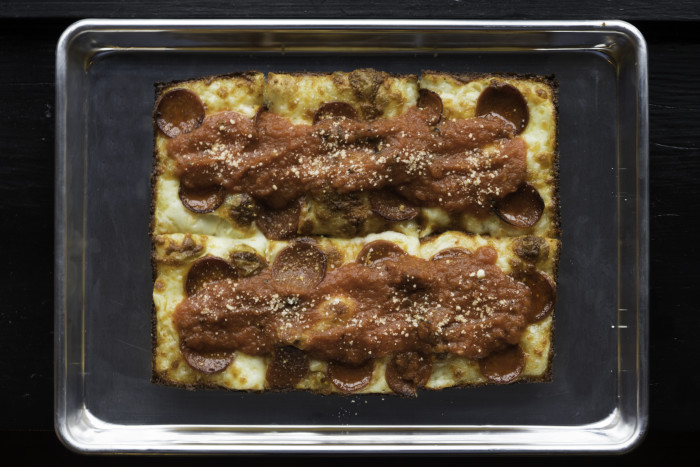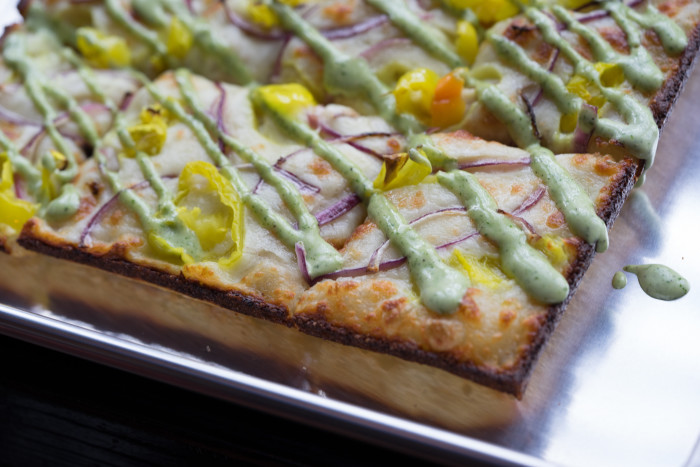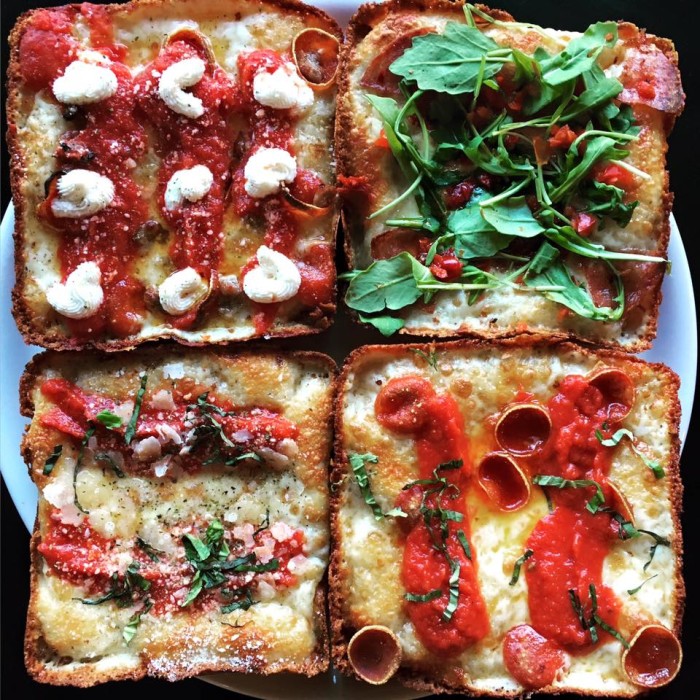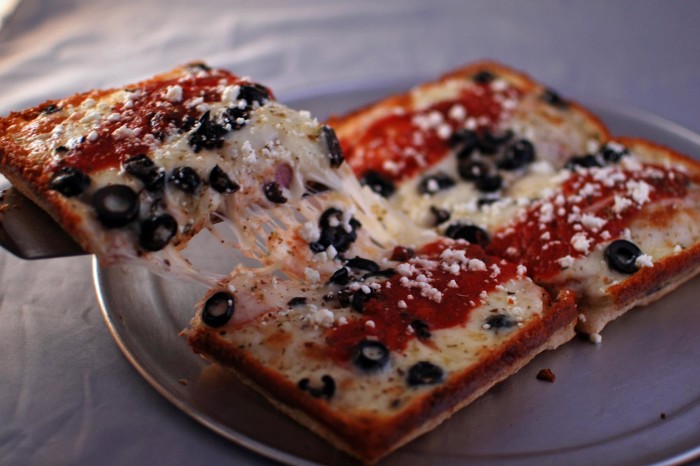Why You Soon Will Crave Detroit-Style Pizza (And Where To Find It)
I grew up outside of Detroit, which means I understand certain little-known facts of life (Ohio is the worst, God hates the Lions) and about food (Detroit makes a far better corned beef sandwich than New York, Vernors pop will cure just about any physical ailment, and Detroit makes the best pan pizza in the country).
New York is the greatest pizza city on earth, but Detroit deserves to take Chicago's place in that ridiculous New York or Chicago pizza debate. The only reason it hasn't already is that if you're from outside of Southeast Michigan, you probably haven't heard of it. Or at least you hadn't until recently.
But just like Rodriguez rose out of obscurity after decades of sitting in Detroit unappreciated while the world swallowed up Kid Rock, Detroit's square pan pizza is finally proving that Michigan has more to offer the pizza world than Domino's and Little Caesars.
In the last year, at least three Detroit-style pizza places have opened in other cities across the country, including the brand-new Williamsburg, Brooklyn, restaurant Emmy Squared, a Detroit-inspired spinoff of beloved Clinton Hill pizzeria Emily.
So what is Detroit-style pizza? According to Emily Hyland, who owns Emmy Squared and Emily with her husband, Matt, there are five characteristics: It's baked in a square/rectangular pan, there's a frico crust, a crispy bottom, an airy middle and stripes of sauce on top.
Most of those characteristics came from sfincione, a focaccia-like pizza sold in Palermo bakeries. The story of how sfincione got kicked all the way from under the boot to Motown is a bit murky, but here's what we do know:
In the 1930s, Buddy's — the place that started it all — was just another blind pig (what they called speakeasies in Detroit back when speakeasies meant more than having a bartender with suspenders and a mustache).
By the time Buddy's got a license to sell its booze in 1944, American troops were getting shipped out to Europe to fight in WWII, and there weren't enough customers filling up the bar stools to keep the place in business. Buddy's needed something to make its customers thirsty.
In 1946, then-owner Gus Guerra started cooking what he called Sicilian pizza, baked in the same blue steel drip pans used to hold small parts at the city's auto factory assembly lines. And just like Blue Steel made the career of your favorite male model, it also transformed the landscape of Detroit pizza, because without the pans, you wouldn't get the crust. And with Detroit style, unlike most pizza, the crust is everything.
"Just like Rodriguez rose out of obscurity after decades of sitting in Detroit unappreciated while the world swallowed up Kid Rock, Detroit's square pan pizza is finally proving that Michigan has more to offer the pizza world than Domino's."
The saltwater yeasted dough is stretched across the pan — which has been seasoned, oiled and wiped down, like a cast-iron skillet — and proofed for two to three hours, allowing the dough to rise, which is what gives the inside its soft, airy quality and moderate thickness (it also means that restaurants need to keep an insane amount of pans. Buddy's has 600 to 1,000 pans at every location, according to Wesley Pikula, the restaurant's VP of operations, and Matt Hyland says Emmy Squared had to order more pans within a few days of opening).
The pan gives the bottom and sides of the crust their brown, crunchy texture. The rich, buttery flavor of the crust comes from elsewhere: the cheese.
Buddy's, which now has 11 locations across the Detroit metro area, uses Wisconsin brick cheese from a producer in Wisconsin that adheres to Buddy's precise specifications. Brick is an aged cheese, and Buddy's needs a specific flavor and fat content, among other requirements. The cheese resembles young cheddar more than mozzarella, with a higher fat content and a bit of tang. In addition to imparting flavor, the extra fat content from the cheese — which hits the pie before the sauce — releases extra oil and butterfat that seep directly into the dough.
The cheese melts across the pie, reaching every corner before hitting the pan and caramelizing, forming its own thin frico crust that attaches to the dough and rises every so slightly above the pizza — similar to the crust that forms on a grilled-cheese sandwich when the cheese spills out onto the pan.
This frico crust is the reason Detroiters who aren't smart enough to order only small pizzas — on which every slice is a corner — have been fighting over corner slices for 70 years. The corner is the best bite of the pizza, with the most caramelized cheese and the crispiest, most buttery flavor.
The cheesy frico crust is also, in large part, what inspired the Hylands to bring Detroit Pizza to Brooklyn. According to Emily, they knew they wanted something crispy and pan-baked, but the frico crust on the Detroit pie was the kicker. Many frozen Buddy's pizza deliveries to Brooklyn and a lot of experimentation later, and Emmy Squared has finally arrived.
I dropped by for a taste recently, and while there are some slight differences, Emmy's execution is extremely impressive, from the frico crust to the way the sauce is spooned on top of the pie, in separate rows, leaving spaces with only cheese and toppings. But just like the pizza back in Detroit, the sauce is tangy enough (though less zesty) that the taste remains in your mouth even in sauceless bites.
The element I was most worried about was the crust, and Emmy nailed it, using the same exact amount of dough as a thin, wood-fired Neapolitan-style pie at Emily.
One welcome difference from traditional Detroit style is that Emmy puts the toppings on the top, where they belong. In its classic pie, which calls for pepperoni, Detroit-style pizza traditionally puts the pepperoni at the bottom, pushed directly into the dough. This, to me, was always the Detroit style's major downfall. They're called toppings for a reason.
While Emmy's probably won't give New Yorkers an understanding of why Ohio is the worst or what it's like to root for a football team hated by God, it will teach them that Detroit pizza is The Truth, one convert at a time.
Where else to get Detroit-style pizza:
Denver
Detroit natives Giles Flanigan and Jeff Smokevitch named their restaurant, which opened in June 2015, after the blue steel pans used to bake Detroit-style pies. The restaurant also sticks to Detroit tradition by using brick cheese (blended with cheddar and mozzarella). And like Brown Dog — Smokevitch's other restaurant, in Telluride, Colorado — Blue Pan serves a variety of other styles of pizza in addition to Detroit square (which, yes, is actually rectangular).
Austin
Brothers Zane and Brandon Hunt grew up in Detroit and brought their childhood pizza to Austin. Since 2011, they've been slinging square pies out of a trailer in East Austin, and opened their first brick-and-mortar location in May 2015 and another earlier this year.
Detroit metro area
Cloverleaf and Loui's
Buddy's might be the most popular of the Detroit pizza joints, but Cloverleaf and Loui's — which both have Buddy's roots — have loyal followings that argue about their superiority.
Buddy's founder Gus Guerra sold the original restaurant in 1953 and opened up Cloverleaf in Eastpointe, Michigan. The restaurant is still family owned and claims to use the original recipe used at the first Buddy's.
Buddy's pizza chef Louis Tourtois fled the original restaurant when it was sold a second time in 1970. Three years later, he opened his own spot in Hazel Park that still has the best atmosphere of the Big 3. This low-key, tavern-like establishment has a long bar stretching across the restaurant and Chianti bottles in straw baskets hanging from the wall.





